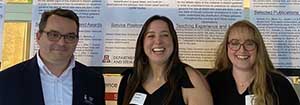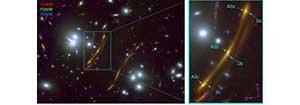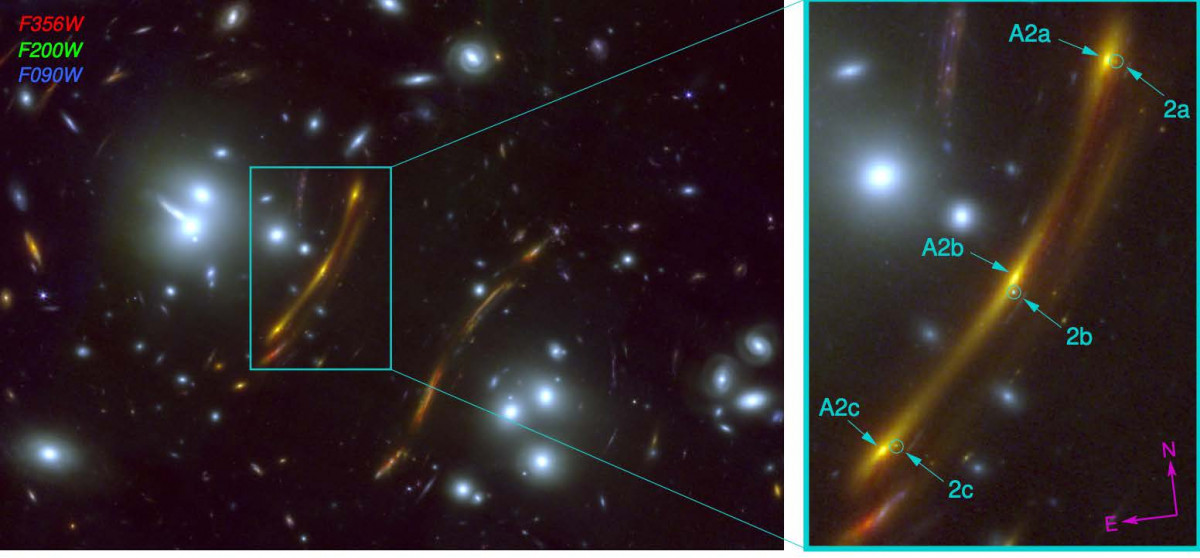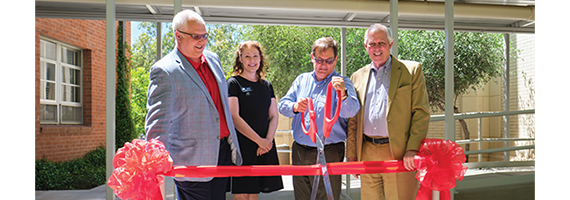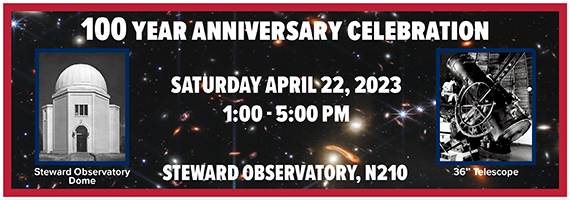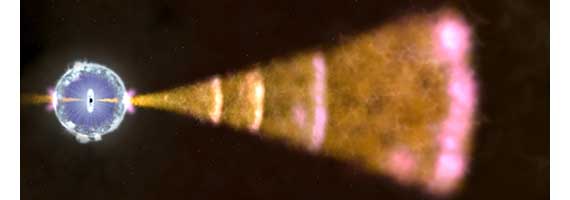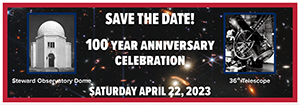On Oct. 9, a pulse of intense radiation swept through the solar system, so exceptional that astronomers quickly dubbed it the BOAT – the brightest of all time. The source was a gamma-ray burst, or GRB – the most powerful class of explosions in the universe.
The burst triggered detectors on numerous spacecraft, and observatories around the globe followed up. After combing through all of the data, astronomers can now characterize just how bright it was and better understand its scientific impact. Two research teams at the University of Arizona joined the international effort to obtain and analyze the data to better understand what causes these outbursts of cosmic proportions. Papers describing the results will appear in a focus issue of The Astrophysical Journal Letters.
Observations of the burst span the electromagnetic spectrum, from radio waves to gamma rays, and include data from many NASA and partner missions, including the National Science Foundation's Karl G. Jansky Very Large Array radio telescope in New Mexico, NASA's NuSTAR observatory and even Voyager 1 in interstellar space. Alexander and other scientists presented new findings about the BOAT at the High Energy Astrophysics Division meeting of the American Astronomical Society in Waikoloa, Hawaii, on Tuesday.
The signal from the gamma ray burst, dubbed GRB 221009A, had been traveling for about 1.9 billion years before it reached Earth, making it among the closest known "long" GRBs, whose initial, or prompt, emission lasts more than two seconds. Astronomers think these bursts represent the birth cry of a black hole that formed when the core of a massive star collapsed under its own weight. As it quickly ingests the surrounding matter, the black hole blasts out jets in opposite directions containing particles accelerated to near the speed of light. These jets pierce through the star, emitting X-rays and gamma rays as they stream into space. As these streams of matter expand out into space, they crash into gas and dust around the star, producing long-lasting "afterglow" light that telescopes can detect across the entire electromagnetic spectrum.
To better understand the cause and properties of GRB 221009A, the UArizona astronomers took advantage of various telescopes capable of observing in multiple wavelengths, including Steward Observatory's Large Binocular Telescope on Mount Graham and the MMT on Mount Hopkins.
"With supernovae and gamma ray bursts, timing is everything, and because of our location, we have access to a superb suite of instruments," said Manisha Shrestha, a postdoctoral research assistant at Steward Observatory who is the first author on another paper. "So, once this gamma ray burst went off, we could follow it up with our own observations very quickly."
"Being so close and so bright, this burst offered us an unprecedented opportunity to gather observations of the afterglow across the electromagnetic spectrum and to test how well our models reflect what's really happening in GRB jets," Alexander added. "Twenty-five years of afterglow models that have worked very well cannot completely explain this jet. In particular, we found a new radio component we don’t fully understand. "This may indicate additional structure within the jet or suggest the need to revise our models of how GRB jets interact with their surroundings."
The jets themselves were not unusually powerful, but they were exceptionally narrow – much like the jet setting of a garden hose – and one was pointed directly at Earth, Alexander explained. The closer to head-on we view a jet, the brighter it appears. Although the afterglow was unexpectedly dim at radio energies, it's likely that GRB 221009A will remain detectable for years, providing a novel opportunity to track the full life cycle of a powerful jet.
With this type of GRB, astronomers also expect to find a brightening supernova – the aftermath of an explosion of a very massive star – a few weeks later, but so far it has proven elusive.
"When we see the brightest gamma ray burst ever recorded, we expect to see a bright supernova associated with it," Shrestha said. "We found that there was no clear signal indicating the presence of supernova features in our data. This is a puzzling discovery, as it is well-established that long GRBs come from the explosion of massive stars."
Shrestha said it could be that a supernova, much fainter than expected, could be "hiding" in the intense afterglow. Another reason could be the location of the GRB, which appeared in a part of the sky just a few degrees above the plane of our own galaxy, where thick dust clouds can greatly dim incoming light.
"Or it could be that there is no supernova present," she said, "which opens up interesting questions about our fundamental understanding of these extremely energetic explosions."
One possible explanation for the lack of the telltale signs of a supernova, the researchers say, could be that the entire star collapsed straight into the black hole instead of ending its life in a spectacular explosion.
Because of its intensity, the burst provides an extraordinarily rare test bed to develop the next generation of physical theories that could explain these phenomena even better, according to the researchers. While additional observations with the James Webb Space Telescope and Hubble Space Telescope are planned over the next few months, the UArizona team is planning to maximize its "home advantage," according to David Sand, an associate professor at Steward Observatory and a co-author on the paper led by Shrestha.
"We have some of the biggest telescopes in the world here in Arizona, and we will be looking at this source again very soon to see how it evolves over time," he said. "We want to learn more about its environment and dive deeper into why it doesn't match our models perfectly. Hopefully, our next observations will help lift some of the mystery around this object."






